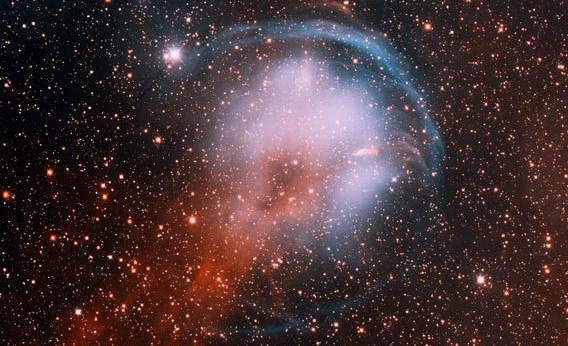Create a free profile to get unlimited access to exclusive videos, sweepstakes, and more!
Cnidareidolia: Jellyfish Nebula

Space exploration is inherently risky. The environment can kill an unprotected human in minutes: the hard vacuum, the heat from a nearby star or the cold from deep space, the gravity gradients near a black hole, the intense radiation blasting out from a massive star, solar storm, or a supernova.
And then, of course, there are the gigantic space jellyfish.
OK, so this isnât some light-years-long cosmic cnidarian. Itâs actually HFG1, a fairly weird nebula created by an aging pair of stars called V664 Cas. The key to understanding the peculiar shape of the gas cloud is in the stars themselves.
One of the two stars is a white dwarf, the exposed core left over when a star grew old, puffed up into a red giant, and blew off its outer layers. That white dwarf is hot, about 50,000 â 60,000° C (90,000 â 110,000° F). The other star is more like the Sun is now, but the two are very close together: They orbit each other every 14 hours, meaning theyâre incredibly close to each other, only a few million kilometers apart at most.
That means that when the first star was still a red giant, it probably engulfed the other star! Drag from the atmosphere of the big star wouldâve drawn the second star in closer, and when the first one finally ejected the last bits of its outer parts, we were left with this weird binary system.
The nebula is formed from material ejected from the system. With a binary star like this we usually get some weird nebula, something shaped like a football or a space station or the Firefox logo or a flaming skull. Like those last two cases, V664 is screaming through space at high velocity (probably several dozen kilometers per second, toward the upper right in the photo) and there happens to be a lot of material in its location, floating between the stars. As it rams this stuff a bow wave forms ahead of it, and the stuff blown out in the other, downwind direction gets left behind as dangly bits. The result is HFG1, which really does look like a giant jellyfish a light year or more across.
This photo was taken by my friend Travis Rector (and Heidi Schweiker), using the Kitt Peak 4-meter telescope, and is the highest-resolution and deepest image of HFG1 Iâve seen. I was rather amazed to find the nebula was only discovered a few years ago, and until this image was taken its fine structure had not been observed. Images like this are more than jaw-droppingly pretty; they tell us a lot about the way stars dieâfor example, the length of the tail and the speed of the starsâ motion tell us the nebula is probably about 100,000 years old. The part of the downwind tail is older, so we can puzzle out the history of the stars over time, too.
We can also learn about the environment around the starsâlike how dense it is, how hot or cold it is, how clumpy it isâby observing nebulae like HFG1. These stars are doing us a favor by poking that interstellar material and letting us see the results.
Mind you, itâs this same environment that would kill a human mercilessly. As gruesome a thought as that is, I find it more than somewhat mitigating to know that the same harsh characteristics in space that would do us in are so conducive to the creation of such magnificent objects.
[Note: âPareidoliaâ is the term for seeing familiar shapes in otherwise completely unrelated patterns, like seeing faces in clouds. Hence the title of this post. I write about pareidolia a lot, as I think itâs totally cool.]














